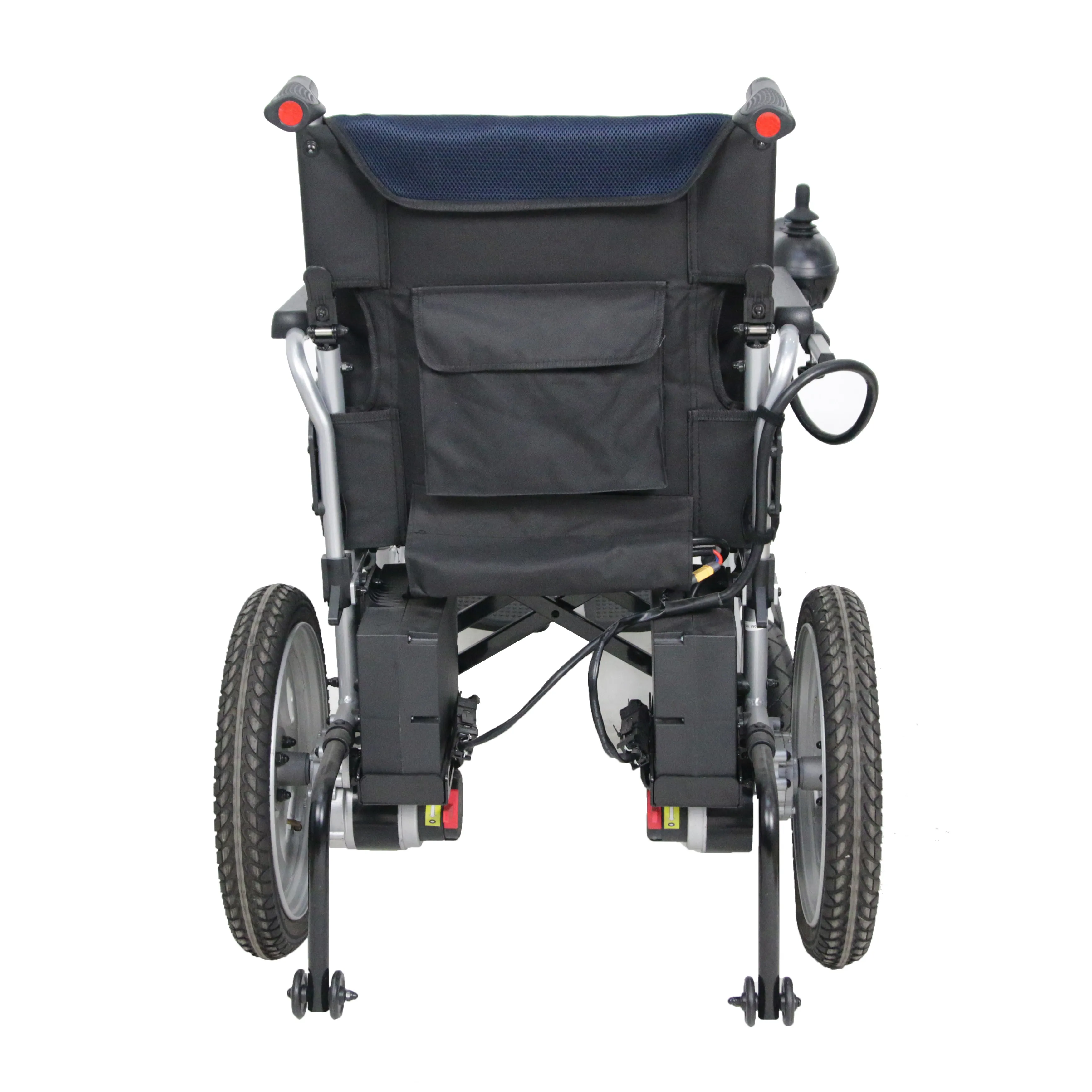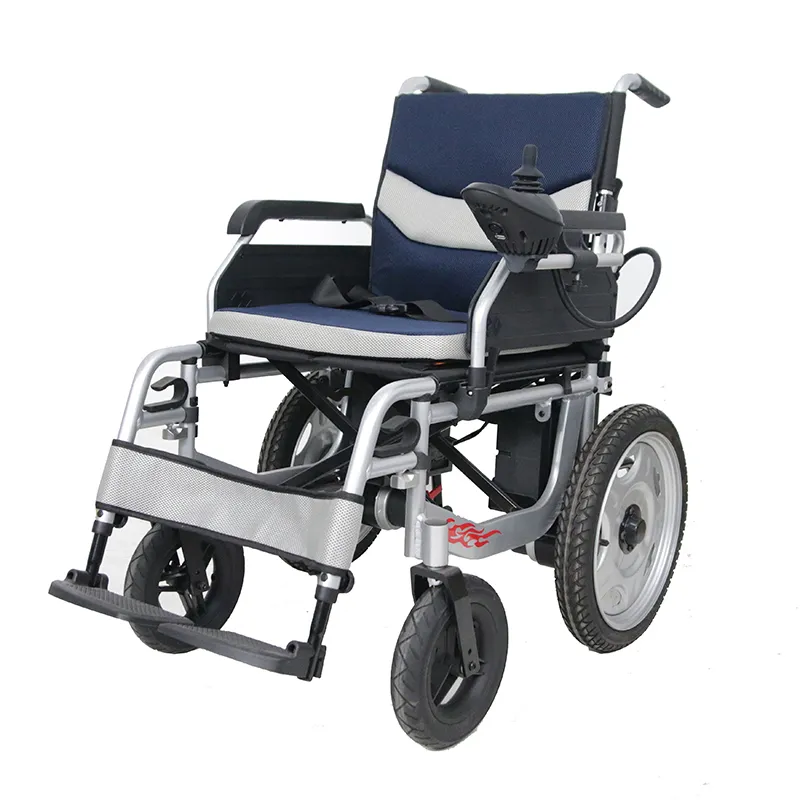Electric wheelchairs have made their way from hospitals and rehabilitation centers to thousands of households, becoming essential tools for many people with limited mobility to live independently and participate in social activities.
However, a common question users ask remains constant: "How far can an electric wheelchair travel?" The answer may seem simple, but it actually involves a complex set of physical and practical issues, including the battery, motor, chassis, weight, road conditions, speed, ambient temperature, and testing methods.
This article will provide a comprehensive and professional explanation of the "range" of an electric wheelchair—including practical calculation examples and purchasing recommendations.
How far can an electric wheelchair travel?
The cruising speed of a typical household/general-purpose electric wheelchair is approximately 6 km/h (think of it as "walking speed"). The range of common models on a single charge generally falls between 10–25 km. A few with larger batteries or high-efficiency drives can reach over 30 km. Extreme off-road/large battery combinations have also been reported to reach 40–50 km. The claimed ranges of power wheelchair manufacturers vary widely. In reality, due to various factors, the ranges are often lower than the nominal values under "ideal operating conditions."
• Note: The ranges given above are not arbitrary; they are based on a comprehensive observation of commercially available model specifications, industry and academic testing, and actual user feedback. Electric wheelchair manufacturers' "maximum range" is often measured under ideal conditions of light load, flat roads, constant speed, and moderate temperature. In reality, your actual range will vary significantly depending on different usage scenarios.

Converting Electric Wheelchair "Battery Capacity" to Available Energy (How to Convert Ah → Wh → km)
To calculate the "range" of an electric wheelchair, the most straightforward physical approach is two-step: convert the battery's ampere-hours (Ah) to watt-hours (Wh), and then divide it by the watt-hours consumed per kilometer (Wh/km) to obtain the theoretical range.
1. Battery Energy Conversion
Battery Energy (Wh) = Voltage (V) × Capacity (Ah).
• For example, a battery in a common household electric wheelchair labeled "24V, 10Ah" has an energy of 24 V × 10 Ah = 240 Wh. This is the theoretically available energy of the battery when fully charged (before deducting efficiency losses).
2. How much energy does an electric wheelchair consume per kilometer? (Wh/km)
To convert Wh to km, you need to know the energy consumption of a power wheelchair per kilometer. This number is not fixed, but industry examples provide a practical range of approximately 25–45 Wh/km (depending on the model and road conditions).
Some lightweight/efficient combinations can achieve ~25–33 Wh/km on flat roads; however, consumption can rise to ~40 Wh/km or even higher when traveling off-road, uphill, or with a heavy load. Research and manufacturer test reports also indicate that the energy consumption per kilometer of an electric wheelchair varies widely, depending on a variety of factors.
3. Theoretical Range Calculation Examples
• Example A (Small Battery): 24 V × 10 Ah = 240 Wh; Using a 30 Wh/km consumption estimate, 240 ÷ 30 = 8 km (theoretical value).
• Example B (Medium Battery): 24 V × 20 Ah = 480 Wh; Using a 30 Wh/km consumption estimate, 480 ÷ 30 = 16 km.
• Example C (Large Battery): 36 V × 20 Ah = 720 Wh; Using a 30 Wh/km consumption estimate, 720 ÷ 30 = 24 km.
• Example D (Manufacturer's High-End Configuration): A 657.7 Wh lithium-ion battery pack was measured to have a range of approximately 20 km (approximately 33 Wh/km), which can be used to infer the engine's consumption.
These examples illustrate that the same Ah corresponds to different Wh in different voltage systems. Therefore, directly comparing Ah is not always effective; comparison requires looking at Wh (energy). Electric wheelchair manufacturers sometimes only list Ah without specifying the voltage, which can be misleading.
Why is there such a significant discrepancy between electric wheelchair manufacturer data and actual range?
— 7 Major Influencing Factors!
Academic research and practice have proven that power wheelchair range is not a single-variable issue. Below are the main factors influencing electric wheelchair range, ranked by importance, with a brief explanation after each:
1. Battery Capacity and Voltage (Wh): More Wh → Longer Range (Direct Energy Source). However, be aware that the battery's age and health significantly affect available energy.
2. Total Vehicle Mass (User Weight + Vehicle Weight + Cargo): Every increase in load linearly or nonlinearly increases rolling resistance and the power required to climb hills, resulting in a decrease in range. Research indicates that weight is highly correlated with power consumption.
3. Road Conditions and Slopes: Flat roads consume the least energy. Slopes, grass, gravel, sand, and other surfaces significantly increase energy consumption, with even a single uphill climb costing several kilometers of range.
4. Speed and Driving Mode: Frequent acceleration and high cruising speeds of power wheelchairs increase air resistance and rolling resistance, reducing range.
5. Tire Type and Pressure: Pneumatic vs. solid tires, as well as underinflated tires, can alter rolling resistance and comfort, thereby affecting Wh/km.
6. Ambient Temperature: Extremely low temperatures reduce the battery's chemical discharge efficiency, reducing the actual usable energy (this is especially noticeable for lithium batteries at low temperatures).
7. Drive/Electronic Control Efficiency and Motor Power: High-efficiency motors and low-loss drive systems can more efficiently convert battery energy into forward motion, reducing losses.
Both academic and field tests have shown that the range of the same battery can often vary by 30%–70% or even more under different users and road conditions. This also explains why electric wheelchair manufacturers often specify "maximum X km" while also noting in their manuals "test conditions: flat road, standard load, constant speed, etc."

Why are electric wheelchair manufacturers' claimed ranges often "overestimated"?
—Because the test conditions differ from reality!
Electric wheelchair manufacturers often conduct standard tests under ideal operating conditions (such as: a single person with a light load, flat road, constant speed, and suitable temperature) to facilitate comparisons between different models. However, these conditions do not correspond to everyday use scenarios:
1. Manufacturers often measure current consumption at a constant speed (e.g., 6 km/h) to derive maximum range; in reality, frequent starting and stopping, turning, and climbing hills consume additional energy.
2. Most users' daily routes include short stops, trips outside their homes, and trips on low slopes, all of which reduce range.
3. Another point: Electric wheelchair manufacturers sometimes omit the "battery aging" factor; a new battery can differ significantly from a two-year-old one.
Therefore, it's wise to use theelectric wheelchair manufacturer's stated range as a "maximum theoretical value" rather than a "guaranteed daily value."
How to make your power wheelchair travel farther?
—15 practical tips!
1. Choose the right battery capacity (Wh): If you need to travel frequently, prioritize a power wheelchair with a higher Wh capacity or a dual-battery solution.
2. Control your vehicle's load: Remove unnecessary items to reduce the weight of each trip.
3. Maintain a moderate speed and avoid sudden acceleration: Cruising at a steady speed saves more energy than frequent starts and stops.
4. Regularly check tire pressure and wheel condition: Low tire pressure significantly increases rolling resistance.
5. Avoid charging and discharging in extreme temperatures: Especially in winter, low temperatures can significantly reduce range.
6. Regularly maintain the battery and battery management system (BMS): Aging batteries reduce capacity and output efficiency.
7. Use genuine chargers and follow charging specifications: Improper charging shortens battery life. 8. Prioritize flat roads when planning your route: Avoid hills and gravel.
9. Perform minor maintenance on the motor bearings and reduction mechanism to reduce mechanical wear.
10. If using your wheelchair indoors for extended periods, consider switching to low-power mode (if your wheelchair has an eco mode).
11. Check that any onboard electrical appliances (lights, heating, etc.) are turned on when not needed.
12. Choose high-efficiency hub motors or external motors: newer motors are more energy-efficient.
13. For extended trips, carry spare batteries or a mobile charger (balance weight and portability).
14. Regularly test battery capacity (after-sales service or third-party service providers can provide battery health reports).
15. Master driving techniques for hills and high and low energy consumption roads (e.g., maintaining inertia and selecting the appropriate gear).
Combining these practical tips, users can typically increase the "rated range" by 10%–30% (depending on the initial difference).

Electric Wheelchair FAQs
Q: The electric wheelchair I bought has a range of 25 km, but I can't even reach 10 km. What should I do?
A: First, check the battery Wh (wh) to see if it's rated, whether the wheelchair is overloaded, whether the tire pressure is normal, and whether the vehicle is being driven on a long slope or in low temperatures. If necessary, have a customer service representative perform a battery health check to confirm whether the capacity has decreased due to counterfeit or aging batteries.
Q: Can the range be increased simply by replacing the battery with a larger Ah battery?
A: In theory, it is possible, but the battery management system (BMS) and charger must be compatible, and attention must be paid to the overall weight, mounting, and heat dissipation design. It is recommended that the electric wheelchair manufacturer or a professional customer service representative evaluate and implement this.
Q: Does an electric wheelchair consume more power the faster it goes?
A: Yes, excessive speed significantly increases air resistance and power consumption, and even short accelerations consume a lot of energy. The energy efficiency zone is usually the cruising speed rated by the electric wheelchair manufacturer.
Can I purchase both manual and power wheelchairs in one shipment?
Certainly. We support mixed orders for various product categories. You can purchase manual, electric, and sports wheelchairs, along with walkers, beds, or shower chairs in a single consolidated shipment. We help clients save on logistics and provide bundled pricing quotes. All goods are packed securely for export, with certification documents included.










